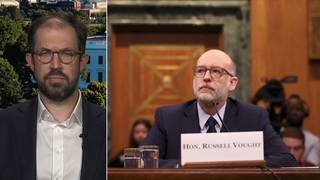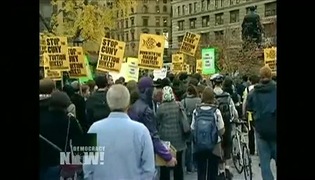
Guests
- Micah Hauptmanfinancial policy counsel for Public Citizen’s Congress Watch division.
- Pamela BrownPh.D. student in sociology at the New School who has helped launch the Occupy Student Debt Campaign pledge of refusal and produced the Debt Resistors’ Operations Manual.
The interest rate for federally subsidized student loans has doubled to 6.8 percent after Congress failed to reach a deal to avoid the hike. A proposal by Democratic Senator Elizabeth Warren to lower student loan interest rates to 0.75 percent — the same rate given to big banks on government loans — also faltered before the deadline. Lawmakers will still have a chance to come to an agreement before the next school year, but whatever they decide will barely impact the massive crisis of U.S. student debt. Student loan debt in the United States stands at about $1 trillion after roughly quadrupling over the past decade. The Congressional Budget Office has forecast a profit of $50.6 billion from the interest it charges students paying back their college debt. We’re joined by two guests: Micah Hauptman, the financial policy counsel for Public Citizen’s Congress Watch division, and Pamela Brown, a Ph.D. student in sociology at the New School, where she helped launch the Occupy Student Debt Campaign pledge of refusal.
Transcript
AMY GOODMAN: We turn to the news that the interest rate for federally subsidized student loans has doubled after Congress failed to reach a deal to avoid the hike. The interest rate on Stafford loans rose to 6.8 percent Monday when a temporary freeze expired. Lawmakers will still have a chance to reach a deal on student debt before the next school year. The impasse in Congress centered around bipartisan differences over whether to cap rates on consolidated loans and whether government profits from the loans should go toward paying down the federal deficit.
Student loan debt in the United States stands at about a trillion dollars, after roughly quadrupling over the past decade. Last month, the Congressional Budget Office forecast a profit of $50.6 billion from the interest it charges students paying back their college debt. A proposal by Democratic Senator Elizabeth Warren to lower student loan interest rates to 0.75 percent—the same rate given to big banks on government loans—also failed to pass recently. This is Senator Warren speaking about the various proposals.
SEN. ELIZABETH WARREN: Our college students already see that the system is rigged against them. They watched Wall Street bankers get bailed out while their parents lost jobs and struggled to hang on to their homes. They see special subsidies for companies that ship jobs overseas and exploit tax loopholes, while the investments in their future and jobs at home disappear. And now Senator Coburn plans to squeeze more profits out of our students. He is fine with the government handing out loans to big banks at incredibly low rates, but he wants our students to pay more. That’s not who we are. This does not reflect our values. We see students drowning in debt, and we should be there to help.
Senator Harkin and Senator Reed have shown great leadership on this issue. They offer a simple solution to prevent interest rates from doubling. Their plan would maintain the current 3.4 percent interest rate for two more years. I’ve also introduced a short-term plan that would cut interest rates even more by offering the exact same rate that the big banks get through the Federal Reserve discount window. I introduced this one-year deal because we need immediate relief while we develop a long-term plan.
AMY GOODMAN: Well, for more on this, we’re joined by two guests. In Washington, D.C., we’re joined by Micah Hauptman, financial policy counsel for Public Citizen’s Congress Watch division. Here in New York, Pamela Brown, Ph.D. student in sociology at New School, where she helped launch the Occupy Student Debt Campaign pledge of refusal and produced the Debt Resistors’ Operations Manual.
We welcome you both to Democracy Now! Let’s go first to Washington to Micah. What’s happening in Washington? Explain exactly how this all broke down.
MICAH HAUPTMAN: Thanks. Great to be here.
Well, as you said, interest rates doubled from 3.4 percent to 6.8 percent on July 1st for federally subsidized loans, and that means that students are going to have to spend an additional approximately $1,000 per year extra on their student loans. So it’s not insignificant. And the—it doesn’t really make sense because current interest rates are at near historic lows, 10-year Treasuries are at about two-and-a-half percent, and the government at the same time is deciding to raise interest rates to 6.8 percent. So there is a wider gap between the rate at which the federal government is borrowing and lending. And in practical terms, that means that the government is going to make a profit. The Congressional Budget Office predicts that the federal government will make about $37 billion this year on federal student loans.
AMY GOODMAN: …going to happen right now?
MICAH HAUPTMAN: I’m sorry?
AMY GOODMAN: What is going to happen right now?
MICAH HAUPTMAN: Well, unfortunately, Congress didn’t act. It couldn’t get its act together to come together and agree on keeping the interest rates low, and instead it went on vacation. So, when Congress returns next week, we hope that they will reconsider a proposal and have a temporary fix to have a lower rate, and that will provide them an opportunity to have a fuller debate on what student loan rates should be.
AMY GOODMAN: Micah, about the difference between how banks are dealt with when it comes to debt and how students are dealt with?
MICAH HAUPTMAN: Well, Senator Warren touches on a really important issue. She’s a consumer advocate champ, and we commend her for raising these issues. She has really touched a nerve with a lot of people, because she shows the imbalances in the system. Banks are allowed to borrow from the Federal Reserve at .75 percent, and now students are going to have to borrow at 6.8 percent. And it really questions what our priorities are. And it’s just unfortunate that the federal government bailed out Wall Street in 2008, the Federal Reserve has continued to prop up large banks for nearly five years, at the same time consumers, homeowners and student borrowers are being given very few options for help.
AMY GOODMAN: Pamela Brown, what needs to happen?
PAMELA BROWN: Well, with this bill, it’s very important to have all of these different political options, but unfortunately they don’t really get to the systemic nature of this crisis. It’s certainly the case that with the Elizabeth Warren bill, that what it does is really exposes the system, and it says, you know, it’s very unlikely that in a real democracy the people would actually vote to have higher interest rates than the banks, for themselves, for a basic need like education. So, in terms of a next step, it really needs—the systemic nature of this problem needs to really be addressed.
And I don’t think that most people realize that there is a real history to debt. The history to debt and the way that we understand debt today really starts with, I’d say, the 1934 Housing Act. And that act actually was a really interesting moment where, for the first time, we had a real partnership between the banks and our government, when we decided that banks would have a way to create a secondary market, where they wouldn’t have to keep mortgages on their books, and they would also have insurance. OK? And the Education Act, which comes out of this moment where people are saying, you know, “We demand rights”—it comes out of the civil rights movement in the '60s—creates Sallie Mae. And that's how we start to really get into all of this student debt. So, the system itself and this act, where we created Sallie Mae, really mirrors the Housing Act exactly. It says, “OK, we’re going to offer insurance, 98 percent of federally backed loans are actually guaranteed, and we’re also going to have a secondary market for student debt for the first time.” And what that does is it really expands the cost of education enormously, just as it did with the housing market. And so, unfortunately, we have enormous costs of education now that people are meant to pay individually.
AMY GOODMAN: Senator Bernie Sanders spoke passionately on the Senate floor last week to call on Congress not to double student loan interest rates.
SEN. BERNIE SANDERS: How can you become a teacher, a childcare worker, a Legal Aid attorney, or even a primary care physician, if the salary you earn will not enable you to pay off your debt and take care of the obligations that you face? So, in other words, this debt is forcing many, many young people into professions which are not necessarily their love. It’s not what they wanted to do; it’s what they have to do in order to earn money to pay off their debts. This debt burden, this crushing debt burden, determines where many young people will live and whether or not they can even afford to buy a home. How do you go out and buy a home if you’re spending 20 or 25 percent of your income paying off your student debt? This debt burden on our young people even determines in some cases whether or not they get married and have kids.
AMY GOODMAN: That was Vermont independent Senator Bernie Sanders. Pam Brown, talk about your own experience in dealing with debt.
PAMELA BROWN: Well, you know, I went to graduate school in the '90s. I went to Columbia. I went to film school, actually. And that was my first experience with debt, because I didn't have any debt coming out of my college education. My family was a very middle-class family and was able to, back then, really afford an amazing education for me. But I did have debt coming out of this experience with Columbia. And it was the first time that I ever thought about, you know, how to pay that back. And it was definitely something where it was a factor that limited what I thought my job prospects really were and the types of jobs that I would take, because I, like most people, really believed that the system was fair and that it worked and that, you know, you work hard, and then you can pay off your—pay off your debt.
AMY GOODMAN: I wanted to turn to the issue of Sallie Mae, the nation’s largest private student lender, as you mentioned. Sallie Mae, spent $1.23 million on lobbying in the first quarter of 2013 alone, nearly half of it—of what it had spent in 2012. On Friday, Senator Warren sent a letter to the CEO of Sallie Mae that read: “While Sallie Mae is finding unique ways to profit from government programs, its borrowers are paying interest rates that are far in excess of the low cost of funds supported by the U.S. taxpayers.”
I also want to read an excerpt from the Debt Resistors’ Operations Manual, which Strike Debt helped produce. It says, quote, “Chances are your university financial aid officials are in cahoots with private lenders. A 2006 investigation by the New York State Attorney General’s Office concluded that the business relationship between lenders and university officials amounted to an 'unholy alliance.'”
Pam Brown, can you talk about this?
PAMELA BROWN: Well, I can even say that when I was a student at Columbia, this is exactly what was happening within their financial aid offices. They were taking kickbacks. This is well known now. And this is a really big problem. Schools are incentivized, at this point, to put people into loans that are not necessarily really good for them. We see this a lot with private loans, where many people who are taking out private loans have not exhausted all of their government options, their federally backed options, which provide not just lower interest rates, but also a whole host of protections, including the right to deferrals and forbearance, things of this nature, also the right to go into different programs, where you might be able to actually lower the amount that you would pay.
AMY GOODMAN: I want to turn to Oregon, what’s happening in Oregon. On the same day that federal student loan interest rates doubled, the Oregon state Senate passed HB 3472, a bill that proposes a pay-it-forward model. The idea is that students attend college without tuition or debt; upon graduation, a percentage of their income would then go into an education fund. Is this a model, Micah, that could work on a larger scale?
MICAH HAUPTMAN: Well, I haven’t seen the particular legislation, but we definitely need innovative solutions to solve our student debt issues.
AMY GOODMAN: Yet, let’s turn for a moment to what the House speaker said, to what John Boehner said. He accused Democrats of failing to stop student loan rates from doubling. He was speaking in June.
SPEAKER JOHN BOEHNER: This morning, I sent a letter to President Obama and asked him for something I thought pretty simple: some leadership. It’s clear that many Senate Democrats are content to see interest rates double on college students. I think that’s unacceptable. The president called for permanent market-based reforms. The House passed such a proposal, and now Senate Democrats are actively blocking the president’s plan. The president has failed to talk about this issue, and he hasn’t lifted a finger to push his own party to pass his own proposal.
AMY GOODMAN: That was John Boehner, the House speaker. Micah Hauptman?
MICAH HAUPTMAN: Yeah, well, it’s unfortunate that there is not consensus on how to solve the problem. We definitely need public policy solutions, and we need our legislators to get serious and deal with student debt issues. As you were saying, Sallie Mae is the largest private originator of student loans in the country, and yet it has access to a federal line of credit for a quarter of a percentage; meanwhile, it’s lending to students at 20 to 40 times that amount. Something needs to be done.
And in the private student loan market, we’re particularly concerned because of the lack of flexible repayment options. Private student loans are largely nondischargeable in bankruptcy. And Public Citizen is particularly concerned about private student loans for two additional reasons: First, private student lenders place forced arbitration clauses within their contracts; and second, because there are inadequate or really lack of repayment option plans to refinance. So, for arbitration clauses in those contracts, lenders stick in, in the fine print of those contracts, clauses that say, “If we do you wrong, if we—if we do you wrong, then you can’t sue us in public court. And basically your claim is going to be relegated to a private arbitration proceeding, where we control the rules of the road and we pick the arbitrator,” and the deck is stacked against consumers from the beginning. And this encourages lenders to engage in the type of predatory practices that Pam was talking about. And they are not held accountable for their actions.
Luckily, the Consumer Financial Protection Bureau, which is the brainchild of Senator Warren, has the authority, under the Dodd-Frank consumer—Wall Street [Reform] and Consumer Protection Act, to restrict or—restrict or outright ban forced arbitration clauses in consumer financial protection—or, consumer financial contracts, including student loan contracts. And we urge them to do so.
And then, regarding the lack of refinancing options, again, we’re in—
AMY GOODMAN: Ten seconds, Micah.
MICAH HAUPTMAN: We’re in record low interest rates, and people should be able to take advantage of those low interest rates and refinance their loans.
AMY GOODMAN: Pam, five seconds.
PAMELA BROWN: Yeah, I just want to—I think we need to contextualize this. The amount that we’re talking about here is maybe $2,600 total over the life of the loan. By no means does this particular public policy solution really address the systemic nature of the problem. We’re going to have to reduce the amount of money that students owe currently.
AMY GOODMAN: I want to thank Pam Brown and Micah Hauptman. That does it for today’s show. We have two specials in the coming days: Thursday, we look at the Pentagon Papers; on Friday, John Lewis on the Voting Rights Act. And we will continue to follow Egypt with Sharif Abdel Kouddous.












Media Options